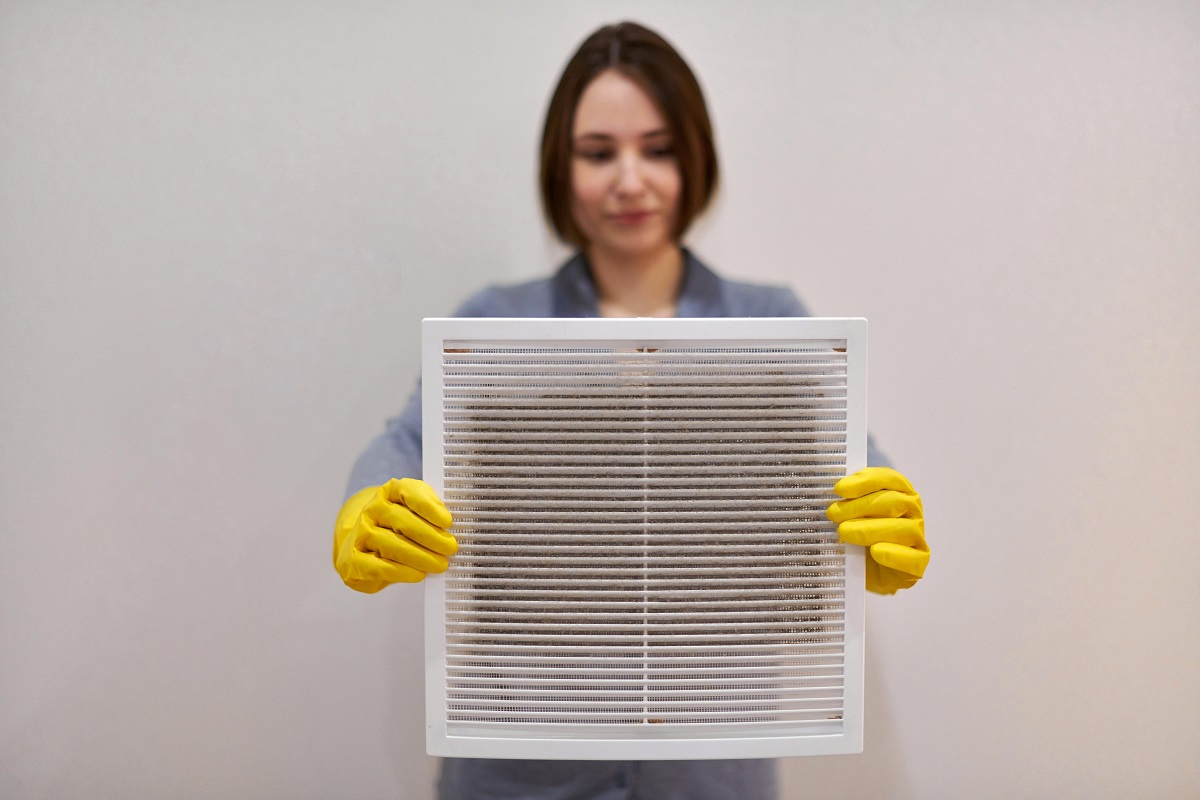Is Your Tap Water Safe? A Guide to Home Water Quality and Testing

Your Ultimate Guide to Home Water Quality and Testing: Is My Tap Water Safe to Drink?
The question "is my tap water safe to drink?" is complex because many of the most serious common pollutants in drinking water at home are invisible and have no taste or smell.
Obvious signs of unhealthy drinking water (like color or odor) are important, but they don't tell the whole story about your water's safety.
True peace of mind about your home's water requires accurate water quality and testing. This is the first step toward creating a healthier home environment.
Nestwell's digital home water assessment services provide a comprehensive, scientifically-backed alternative to unreliable DIY kits and confusing professional lab reports, all without an invasive home visit.
After identifying issues, you can take clear action with vetted water purification systems for residential homes that can reduce lead in home drinking water, provide solutions for hard water problems, and give your family healthy, safe water.
Table of Contents
- Introduction: That Lingering Question About Your Tap Water
- Signs and Pollutants in Water Quality
- Your Options for Water Testing
- Taking Action for Healthy Home Water
Key Takeaways
- Unseen dangers like lead and arsenic are the biggest threats to tap water safety, requiring thorough testing beyond sensory checks.
- DIY kits offer quick but limited insights, while professional labs provide accuracy but at high cost and complexity.
- Digital assessments like Nestwell's deliver affordable, comprehensive insights with clear action plans, no home visits needed.
- Whole-house filtration ensures safe water everywhere, protecting health, plumbing, and appliances for total peace of mind.
Introduction: That Lingering Question About Your Tap Water
Is my tap water safe to drink? It's a question that nearly every person, parent, and homeowner asks at some point. You fill a glass from the kitchen sink, hold it up to the light, and wonder what might be hiding inside. This guide is here to provide the answers you need about home water quality and testing. We are going to walk you through everything, making a confusing topic simple and clear.
It's normal to feel worried or unsure about your home's water. The news often talks about water problems in different cities, and it can make you anxious about your own faucet. This feeling of not knowing is stressful. But you don't have to stay in the dark. This guide will empower you, turning your uncertainty into knowledge and clear action.
We'll explore the signs of poor water quality, your options for testing, and how a modern approach like Nestwell's digital assessment can give you the clear answers and actionable solutions you need. By the end, you'll have a roadmap to ensuring the water in your home is as healthy as possible for you and your family.
What Are the Signs of Unhealthy Drinking Water?
Knowing what to look for is the first step in understanding your water. Some problems are easy to spot, while others are completely hidden. It's important to pay attention to both the obvious signals and the possibility of invisible dangers lurking in your pipes. Learning about these signs can help you decide when it's time to investigate further.
The Obvious Red Flags You Can See, Smell, or Taste
Sometimes, your senses can give you clues about your water. These are clear signs of unhealthy drinking water that you should never ignore. If you notice any of these, it's a definite warning that you need to examine your water's safety more closely.
- Color: Your drinking water should always be clear. If it appears cloudy, milky, brown, orange, yellow, or even has a blue or green tint, it indicates a problem. Brown or orange water can mean there is rust in your pipes. Cloudy water can be caused by air bubbles, but it can also signal other issues.
- Smell: Water shouldn't have a strong odor. A "rotten egg" smell often points to sulfur bacteria, which can happen naturally but is unpleasant. A chemical or bleach-like smell could mean there's too much chlorine used in city water treatment. A fishy or earthy smell might suggest organic matter in the water source.
- Taste: Just like with smell, your water shouldn't have a noticeable flavor. A metallic taste is a big red flag for metals like iron, copper, or even lead from old plumbing. A salty taste could mean high levels of sodium or chloride, possibly from road salt runoff getting into the water supply.
- Feel: How your water feels can also be a sign. Hard water, which has a lot of minerals like calcium and magnesium, will leave white, chalky residue on your faucets, shower doors, and dishes. It can also make your skin feel dry and itchy after a shower and your hair feel dull. A greasy film on the water's surface is another warning sign.
The Invisible Dangers: What You Can't Detect
While the warning signs you can see, smell, or taste are important, what's truly concerning is what you can't detect. The most serious health risks of poor home water quality frequently come from contaminants that are colorless, odorless, and tasteless. This is why you cannot rely on your senses alone to know if your water is safe.
Dangerous substances like lead, arsenic, pesticides, industrial chemicals, and certain types of bacteria can be present in your water without you ever knowing it. Lead can leach from old pipes and solder, posing a significant risk to brain development in children. Arsenic can occur naturally in groundwater but is linked to long-term health problems.
These invisible threats are why a simple sensory check isn't enough. You might have water that looks, smells, and tastes perfectly fine, but it could still contain harmful pollutants. The only way to achieve true peace of mind is through proper, thorough analysis that goes beyond what your eyes and nose can tell you.
What Are the Common Pollutants in Drinking Water at Home?
When we talk about unsafe water, we're talking about contaminants. There are many common pollutants in drinking water at home, and they come from a variety of sources. Some come from the environment, like minerals in the ground or runoff from farms. Others come from the pipes and plumbing right inside your house. Understanding these different types of pollutants is key to knowing what you're up against and how to fix it.
A Breakdown of Potential Contaminants
To make it easier to understand, we can group these pollutants into a few main categories. Each category presents different risks and may require a different type of solution.
- Heavy Metals: This group includes some of the most well-known water dangers. Lead is a major concern, especially in homes built before 1986, as it was used in pipes and solder. It is highly toxic, even at low levels. Arsenic is another dangerous metal that can seep into groundwater from natural deposits or industrial waste. Mercury and copper can also find their way into water supplies.
- Chemicals & VOCs: A wide range of chemicals can contaminate water. Volatile Organic Compounds (VOCs) are chemicals that can be released from industrial products and pollution. Pesticides and herbicides used in agriculture can run off into rivers and groundwater, eventually reaching your tap. Chlorine, used by cities to disinfect water, can react with other matter to form byproducts like trihalomethanes (TTHMs), which are a health concern.
- Biological Contaminants: These are living organisms that can make you sick. The most common are bacteria, like E. coli and Coliform, which often get into the water supply from sewage or animal waste. Viruses and parasites like Giardia and Cryptosporidium can also be present, causing stomach and intestinal problems.
- Minerals: Not all pollutants are dangerous, but they can still cause big problems. Minerals like calcium and magnesium are what cause "hard water." While not a direct health risk, hard water can damage your pipes and appliances by creating scale buildup. It also makes soap less effective and can lead to dry skin and dull hair.
A Special Concern: How to Reduce Lead in Home Drinking Water
Lead deserves special attention because it is so harmful, especially for children and pregnant women. There is no safe level of lead exposure. Since it is invisible and has no taste, you won't know it's there without a proper test. If you are worried about lead, the first step is always to find out if it's in your water.
The most effective way to reduce lead in home drinking water is by using a targeted water filter. Specific filters, such as those certified to remove lead, can be installed right at your kitchen sink (a point-of-use filter) or for your entire house (a whole-house system). Flushing your pipes by running cold water for a few minutes before using it for drinking or cooking can also help reduce lead exposure, but filtration is the most reliable solution.
Can Mold Affect Your Water?
People often wonder about water testing for mold spores. It is important to understand that mold in your home's main water supply is not a common problem. Municipal water systems are treated to kill these kinds of organisms.
However, the connection between water and mold is still very important for a healthy home. Mold thrives in damp, humid places. A leaky pipe under your sink, a damp basement, or poor ventilation in your bathroom can all create the perfect environment for mold to grow. This mold releases spores into the air you breathe, which can cause allergies, asthma attacks, and other respiratory issues. While you might not drink the mold, its presence is a sign of a water-related problem in your home that affects your indoor air quality. A holistic home health assessment looks at these connections to give you a full picture of your environment.
How Can You Check Tap Water Quality Yourself? Your 3 Main Options
So, you've decided you want to know exactly what's in your water. That's a great decision. But what's the next step? There are a few different paths you can take when it comes to how to check tap water quality yourself. Each option has its own set of pros and cons, from quick and cheap tests to highly detailed professional analyses. Let's break down your three main choices so you can decide which one is right for you.
Option 1: The Reason Why People Use DIY Kits
When you walk into a hardware store, you'll likely see do-it-yourself water test kits on the shelf. Many people search for the best home water testing kits for contaminants because they seem like an easy and affordable first step. These kits usually come with test strips that you dip into a water sample. The strip changes color, and you compare it to a chart to see the results.
The main advantage of these kits is their low cost and instant results. You can get a basic idea of certain elements in your water within minutes. However, this convenience comes with major downsides. DIY kits are often not very accurate and can give you a false sense of security or unnecessary alarm. They typically only test for a very small number of things, like chlorine, pH, and hardness, completely missing dangerous contaminants like lead, arsenic, or VOCs. Furthermore, they offer zero guidance on what the results mean or what you should do about them. They give you a tiny glimpse, not the full picture.
Option 2: The Reason Why People Hire Professional Labs
The traditional method for getting a detailed water analysis is to hire a professional laboratory. This involves having a technician come to your home to collect a water sample, or the lab sending you a special container to collect it yourself and mail it back. The lab then uses sophisticated equipment to run a wide range of tests.
The biggest pro of this method is accuracy. Professional lab tests are the gold standard for identifying exactly what is in your water and at what levels. They can test for hundreds of different contaminants. The cons, however, are significant. This process is very expensive, often costing hundreds or even thousands of dollars. It can also be slow, taking weeks to get your results. When the report finally arrives, it's usually a dense, multi-page document filled with scientific jargon, chemical names, and numbers that are nearly impossible for the average homeowner to understand. You get the data, but no clear path to a solution.
Option 3: The Modern, Smarter Way with Digital Home Water Assessment Services
There is a third option that combines the convenience of a DIY approach with the accuracy of professional analysis, all while being affordable and easy to understand. Digital home water assessment services, like the one offered by Nestwell, represent a modern, smarter way to check your water.
This process is completely non-invasive, meaning no one needs to come to your home. Instead, we use technology and data to build a complete profile of your water. We analyze hundreds of powerful data points, including your local water utility's official reports, geological surveys of your area's groundwater, information about industrial activity nearby, and data about your home itself, such as its age and the type of plumbing it likely has. By cross-referencing all this information, we create a highly accurate and comprehensive risk profile for your specific address. The benefits are clear: it is fast, affordable, and incredibly thorough. Most importantly, it doesn't just give you raw data; it connects that data to a personalized, easy-to-understand report with a clear action plan.
From Confusing Data to Clear Answers: Understanding Home Water Quality Reports
Getting a water test is only half the battle. The other half is figuring out what the results actually mean for your family's health. This is where many people get stuck. If you've ever seen a report from a professional lab, you know it can be overwhelming. The process of understanding home water quality reports should not require a science degree.
Imagine getting a report that says, "Trihalomethanes (TTHM): 78 µg/L" or "Hardness as CaCO3: 210 mg/L." What do these numbers mean? Is 78 high or low? Is 210 a problem? Without context, these facts are useless and only create more confusion and anxiety. You're left guessing about the actual risks and what steps, if any, you should take.
This is where the Nestwell approach is fundamentally different. We believe in providing clarity, not complexity. We start by giving you a single, intuitive Healthy Home Score. This score gives you an immediate, at-a-glance understanding of your home's overall environmental health, including your water quality. It's a simple starting point that tells you where you stand.
Our personalized Nestwell report goes deeper, but it does so in a way anyone can understand.
- It translates complex data into plain English. We take those scientific terms and numbers and explain what they mean in simple, direct language. Instead of just giving you a number for lead, we tell you if the level detected poses a risk and why.
- It prioritizes risks for you. Your report won't just be a long list of contaminants. It will highlight the most significant issues for your home, telling you what you need to focus on first. This helps you direct your resources where they will have the most impact.
- It explains why something is a concern. We provide context. The report will explain why a specific contaminant is a concern for your family's health, connecting the data directly to your well-being.
- It empowers you with knowledge, not just numbers. Our goal is to move you from a state of worry to a position of power. With a clear, understandable report, you gain the confidence to make smart decisions for your home and health.
Taking Control: How to Get Healthy Home Water
Once you have clear answers about your water quality, the next step is taking action. Knowing what's wrong is important, but it's the solutions that truly matter. This section is all about how to get healthy home water. The good news is that for almost every water quality issue, there is an effective and accessible solution.
After receiving your personalized Nestwell report, you are not left on your own to figure out what to do. Your report will guide you toward an action plan, and the Nestwell Certified Marketplace provides a seamless way to find the right products for your specific needs. We've taken the guesswork out of choosing a solution by vetting every product for quality and effectiveness.
Choosing the Right Water Purification Systems for Residential Use
When it comes to treating your water, you will find many different water purification systems for residential homes. The best system for you depends entirely on what your Nestwell report identifies. There is no one-size-fits-all answer. The two main categories of solutions are point-of-use systems and whole-house systems.
- Point-of-Use (POU) Filters: These systems treat water in one specific location, like your kitchen sink. Examples include under-sink filters, faucet-mounted filters, and countertop purifiers. POU systems are a great choice if your main goal is to purify the water you use for drinking and cooking. They are highly effective at removing specific contaminants like lead, chlorine, and VOCs from the water at a single tap.
- Whole-House (POE) Systems: Also known as point-of-entry systems, these are installed where the main water line enters your home. They treat all the water you use, from the kitchen sink to the showers and washing machine. This is the most comprehensive solution for protecting your family and your home.
What Are the Whole House Water Filtration Benefits?
Installing a system that treats your entire home's water supply offers complete peace of mind and protection. The whole house water filtration benefits extend far beyond just having better-tasting drinking water.
Safe, clean water from every single tap. This is the biggest benefit. You can drink, cook, and bathe with confidence, knowing that all the water in your home is being purified. This is especially important for children, who might drink from a bathroom faucet.
Protects your plumbing and appliances. Contaminants like hard water minerals, chlorine, and sediment can damage your pipes, water heater, dishwasher, and washing machine over time. A whole-house system acts like a shield, preventing scale buildup and corrosion, which can extend the life of your expensive appliances.
Softer skin and healthier hair. The chlorine and hard minerals found in much of our tap water can strip natural oils from your skin and hair, leaving them dry, itchy, and irritated. Filtering this water before it reaches your shower can lead to noticeable improvements in skin and hair health.
Total peace of mind for your entire family. With a whole-house system, you no longer have to worry about which tap is safe or whether your family is being exposed to hidden contaminants. It provides a comprehensive, set-it-and-forget-it solution for healthy water throughout your home.
Vetted Solutions for Hard Water Problems and More
The Nestwell Certified Marketplace is designed to make your next step as simple as possible. Your personalized report might identify a specific issue, and the marketplace will point you to the exact products designed to solve it. For example, if your report shows very hard water, we provide vetted solutions for hard water problems, like high-quality water softeners or salt-free conditioners that are proven to work.
You won't have to spend hours online reading reviews and trying to compare dozens of different brands. We've already done the research for you. Every product in our marketplace has been carefully selected based on its performance, certifications, and reliability. This removes the stress and uncertainty from buying a water filter, ensuring you invest in a solution that will truly make your home healthier.
Frequently Asked Questions (FAQ)
Q: What are the biggest health risks of poor home water quality?
A: The health risks of poor home water quality can be broken into short-term and long-term problems. Short-term issues can include stomach problems like nausea or diarrhea from bacteria, as well as skin irritation and rashes from chlorine or other chemicals. The long-term risks are more serious and can result from chronic exposure to substances like lead, which can affect brain development, or arsenic and certain chemicals, which have been linked to an increased risk of chronic health conditions.
Q: What are the best home water testing kits for contaminants and how does Nestwell compare?
A: While some people consider the best home water testing kits for contaminants to be basic test strips for a quick check of pH or chlorine, they are very limited. These DIY kits are often unreliable and fail to test for the most dangerous pollutants. Nestwell's digital home water assessment services are far superior. Instead of a simple dip strip, we analyze hundreds of local and home-specific data points to create a report that is much more comprehensive, accurate, and actionable, all without the known unreliability of a cheap DIY kit.
Q: How do whole house water filtration benefits compare to a simple pitcher filter?
A: A pitcher filter is a good start, but it only filters a small amount of drinking water at a time and often misses key contaminants. The whole house water filtration benefits are much more comprehensive. A whole-house system purifies every drop of water entering your home. This means you get safe water for drinking, cooking, bathing, washing clothes, and more. It also protects your plumbing and appliances from damage, which a pitcher filter cannot do. It provides total protection for your entire home.
Q: My water has a funny smell. Is that one of the definitive signs of unhealthy drinking water?
A: Yes, a noticeable odor is definitely one of the signs of unhealthy drinking water and serves as an important warning that something is wrong. A "rotten egg" or chemical smell should prompt you to investigate further. However, it's critical to remember that many of the most dangerous contaminants, like lead and arsenic, are completely odorless and tasteless. Therefore, the only way to be absolutely certain about your water's safety is with a comprehensive analysis, like the assessment Nestwell provides.






